What does a fearsome-looking beast like a snapper turtle eat? Well, just about anything, including fruits, vegetables, and a huge list of animals that often fall prey to its devastating bite and deadly ambush tactics. After all, the snapper is an opportunistic reptile; if something looks even remotely edible, it’ll likely end up in its stomach.
If you’re the owner of a snapping turtle, however, keep in mind that not all foods are good for snappers in captivity. You should therefore exercise caution when feeding your exotic pet.
With that in mind, let’s get right into what snapping turtles enjoy chowing down on!
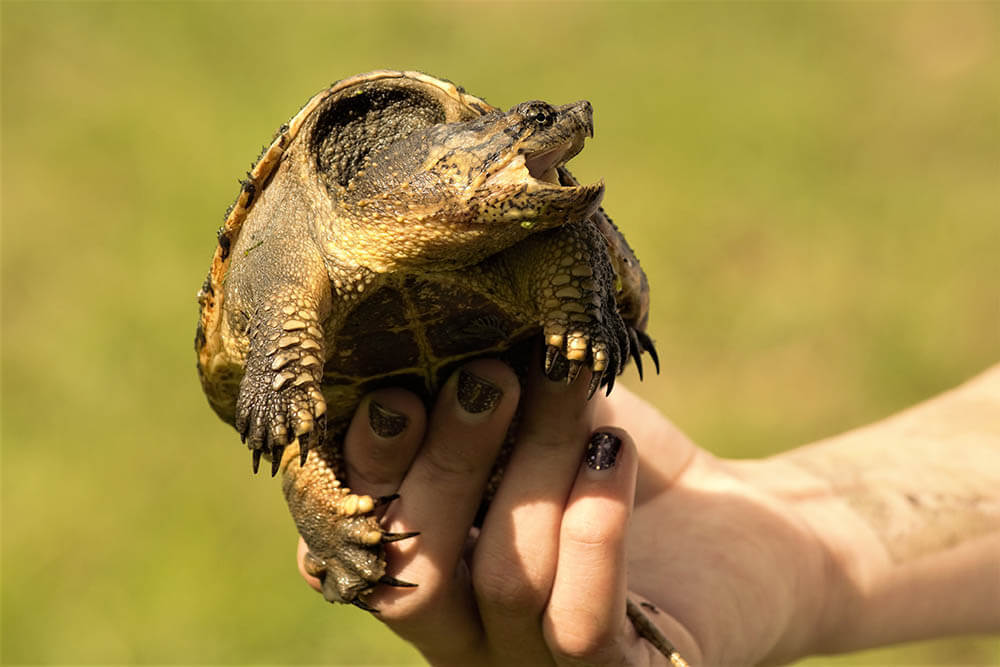
What Snapping Turtles Eat
As omnivores, snapping turtles eat both meat and plants.
Take note, however, that while snappers will eat anything they can find, they still need the right nutrients from the right foods to stay healthy. In fact, they can get ill from ingesting inappropriate foods. If you’re the keeper of your very own snapper, it’s therefore your responsibility to make sure it eats right.
The foods snapping turtles eat can be categorized into meat, vegetables, fruits, and other types of plant matter. Pet owners can also feed their exotic animals commercially prepared versions of these foods.
Meat
Like all animals, snapping turtles need protein for strong healthy bones. Turtles in particular also need this nutrient to keep their shell healthy.
Below are the primary sources of meat for snappers:
Insects and arachnids
- Ants
- Crickets
- Dragonflies
- Grasshoppers
- Mealworms
- Roaches
- Spiders
- Waxworms
Worms
- Bloodworms
- Earthworms
- Leeches
Fish
- Feeder fish
- Guppies
- Minnows
Crustaceans
- Crayfish
- Ghost shrimp
- Shrimp
Birds
- Bird eggs
- Chickens and chicks
- Ducks and ducklings
- Geese and goslings
- Mallards
- Nestlings
- Shredded chicken
- Shredded turkey
- Small birds
- Swans and cygnets
Reptiles and amphibians
- Frogs and tadpoles
- Newts
- Salamanders
- Small snakes
- Small turtles
Gastropods
- Slugs
- Small snails
Mammals
- Beavers
- Mature and immature rodents
- Rabbits
- Raccoons
- Squirrels
Misc
- Carrion
Snappers can find most of these prey animals in the wild. As nocturnal ambush predators, they dive deep underwater, then, leaving only their tongue sticking out, bury themselves in the sand at the bottom of the stream, pond, river, lake, or swamp. This tongue resembles a worm, allowing a turtle to lure unsuspecting prey into striking distance.
Other snappers are more proactive, seeking out prey to kill and consume.
If you’re the owner of a snapping turtle, know that foods such as insects, mealworms, worms, crayfish, minnows, guppies, feeder fish, and frozen-thawed baby rodents can be purchased at exotic pet stores.
Keep in mind that while it’s natural for a wild snapper to catch wild prey, you should avoid feeding a pet snapper any foods caught in the wild, as these could be contaminated with diseases and toxins that can harm its health.
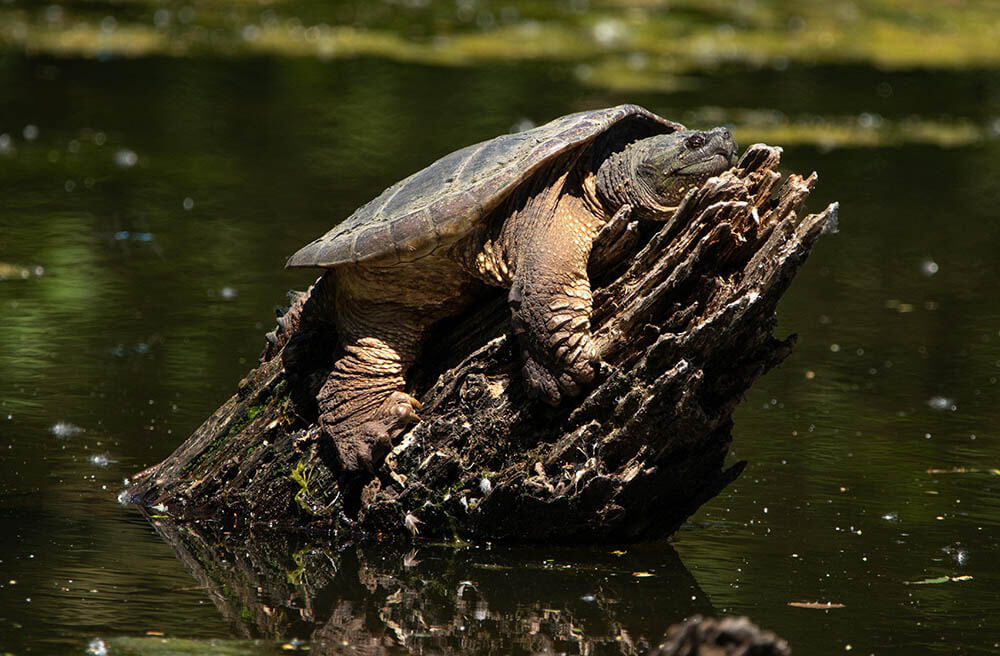
Vegetables and plants
Snapping turtles also feed on vegetables and plants as they boast many nutrients essential to their survival.
Below are the veggies and plants snappers typically consume:
- Algae
- Beet greens
- Bog buttons
- Bog moss
- Carrots
- Cattails
- Celery
- Chinese cabbages
- Collard greens
- Common arrowheads
- Corn
- Cucumbers
- Dandelion greens
- Dill weed
- Duckweed
- Fern (water)
- Grass
- Hyacinth (water)
- Hydrilla
- Java ferns
- Kale
- Leafy greens
- Lettuce
- Lettuce (water)
- Lili pads
- Lilies (water)
- Mermaid weed
- Moss
- Mustard greens
- Parsley
- Romaine lettuce
- Turnip greens
- Waterweed
- Yellow pond lilies
Vegetables and plants compose a third of a snapper’s diet.
Sometimes, snappers in captivity become picky with their food, refusing to eat vegetables and plants and accepting meat only. This may not be so bad for a hatchling, but for an adult turtle, it could be disastrous.
If you have a pet snapping turtle that behaves this way, try giving it veggies and plants only. Once it’s hungry, it will gobble up anything – even the plant matter it would otherwise avoid eating.
We also recommend asking a snapping turtle veterinarian for advice on how to encourage your pet to eat plant matter.
Fruits
Also crucial to a snapping turtle’s health are the following fruits:
- Apples
- Bananas
- Blackberries
- Blueberries
- Cantaloupes
- Carrots
- Cherries
- Grapes
- Honeydews
- Mangoes
- Melons
- Peaches
- Pears
- Pineapples
- Raspberries
- Strawberries
- Tomatoes
- Watermelon
These fruits are chock-full of nutrients snappers need to stay in great health.
If you’re the owner of a captive snapper, however, make sure to feed it fruits in moderation only. This is because fruits contain some substances that can harm your pet when absorbed by its body in abundance. Results of overfeeding may include digestive problems such as stomach upsets.
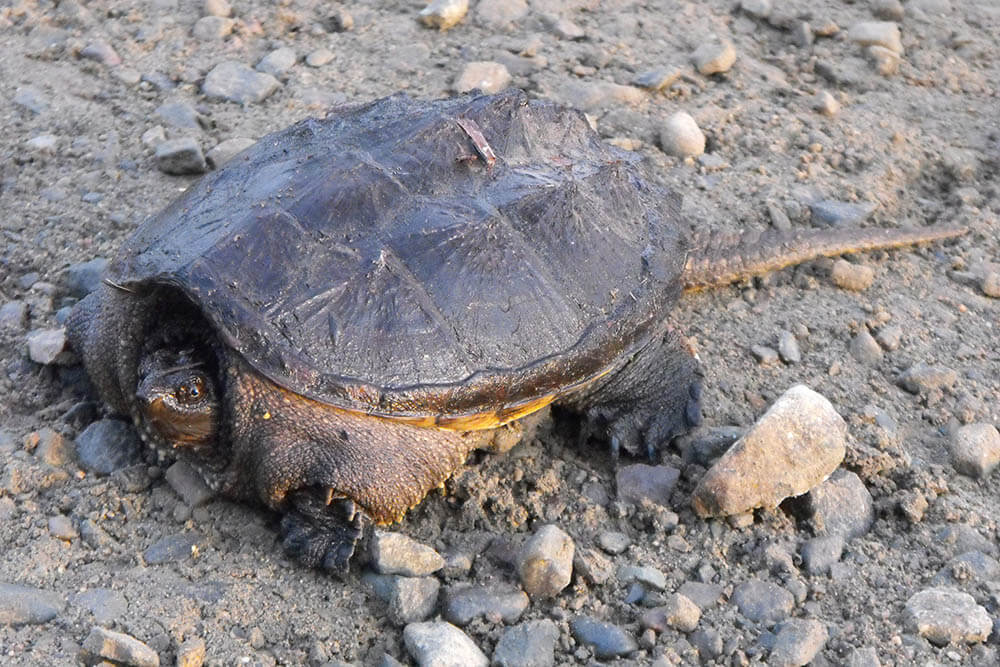
What Pet Snapping Turtles Eat
As already discussed, you can buy many of the foods in the above lists from exotic pet stores, supermarkets, and groceries. Below, we discuss two other types of edibles you can feed a pet snapping turtle.
Commercial foods
Pet owners have the choice of buying food items prepared specifically for snapping turtles. You can obtain these items at exotic pet stores.
Examples of such commercial options include:
- Feeder fish
- Frozen-thawed pinkies (dead baby mice)
- Live or dried mealworms
- Live or dried crickets
- Pellets
While pellets and dried foods are good for snappers, these should make up only about 25% of your pet’s diet. Around 50% should be live prey. The rest should consist of vegetables and plants, with fruits being used as an occasional treat only.
Snappers prefer live prey to dead or dried prey. In addition, live foods encourage hunting behaviors, which satisfy your pet’s predatory instincts while allowing it to enjoy the physical and mental stimulation it needs to stay healthy and happy. The activity also boosts its appetite and makes mealtimes that much more pleasurable.
Supplements
In addition to commercial turtle food, you should also consider feeding your exotic animal supplements. These will make up for any nutritional deficiencies in its regular diet.
We recommend the following supplements for pet snappers:
- Calcium powder
- Multivitamins
- Vitamin D3
Snapping turtles require calcium to maintain strong, healthy shells, bones, muscles, and more. Vitamin D3 helps them absorb the calcium they take in. Lastly, multivitamins provide these turtles with a range of important nutrients that can boost their health and ensure they live a long, happy life.
Remember to seek advice from an exotic animal veterinarian before supplying a captive snapping turtle with supplements; such an expert can determine what supplements are most suitable for your pet and whether or not these supplements are necessary in the first place.
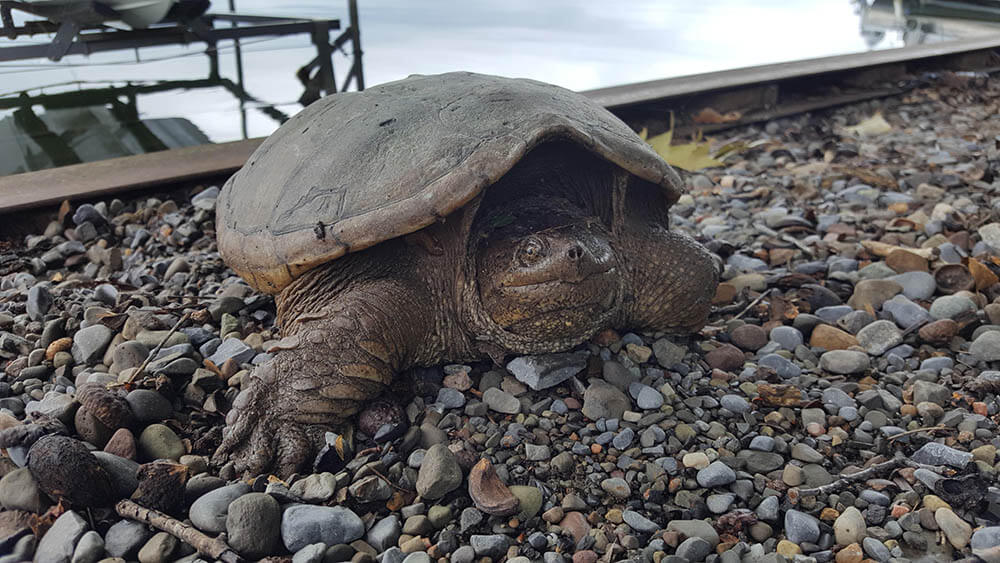
What Pet Snapping Turtles Shouldn’t Eat
True, a snapping turtle will likely eat whatever is unfortunate enough to cross its path. This doesn’t mean, however, that it should.
As a general rule, don’t give your pet any processed foods such as:
- Bacon, sausages, and salami
- Bread
- Candies
- Crackers
- Chips high in salt
- Dairy products (e.g. cheese, milk, yogurt)
- Pasta
- Raw or rotten meat
Processed foods typically contain ingredients that can harm snapping turtles. Bacon and salami, for example, frequently contain a surplus of salt, sugar, additives, and other substances that can cause obesity, kidney issues, and other problems.
Dairy products are also a no-no as the snapping turtle’s digestive system isn’t equipped to handle such foods. Consumption can therefore result in indigestion and other problems.
As for raw or rotten raw meat, these could contain microbes that can make your pet seriously ill.
In addition, don’t give your pet the following sources of animal protein:
- Fishing worms: these may contain toxins that can harm your pet.
- Goldfish: these lack nutritional value for your pet.
- Rose-red minnows: these can cause a vitamin B deficiency in your pet.
- Wild arthropods and worms: these may have diseases or chemicals such as pesticides that can harm your pet.
The following vegetables and plants are bad for pet snappers:
- Asparagus
- Azaleas
- Beets
- Boxwood
- Brussels sprouts
- Cauliflower
- Chards
- Green beans
- Hyacinth
- Onions
- Peppers
- Potatoes
- Pumpkins
- Rhododendrons
- Rhubarbs
- Spinach
- Squash
- Sweet potatoes
- Turnips
- Yew
The following fruits are also bad for snappers, as they’re either high in citric acid or phosphorus or have low nutritional value:
- Apricots
- Avocados
- Coconuts
- Dates
- Grapefruits
- Guavas
- Lemons
- Limes
- Nectarines
- Oranges
- Prunes
- Raisins
If, after eating any of the above foods, your snapping turtle starts exhibiting troubling symptoms such as diarrhea, vomiting, or lethargy, contact a snapper veterinarian immediately. The sooner you act, the greater the possibility of your pet recovering successfully.
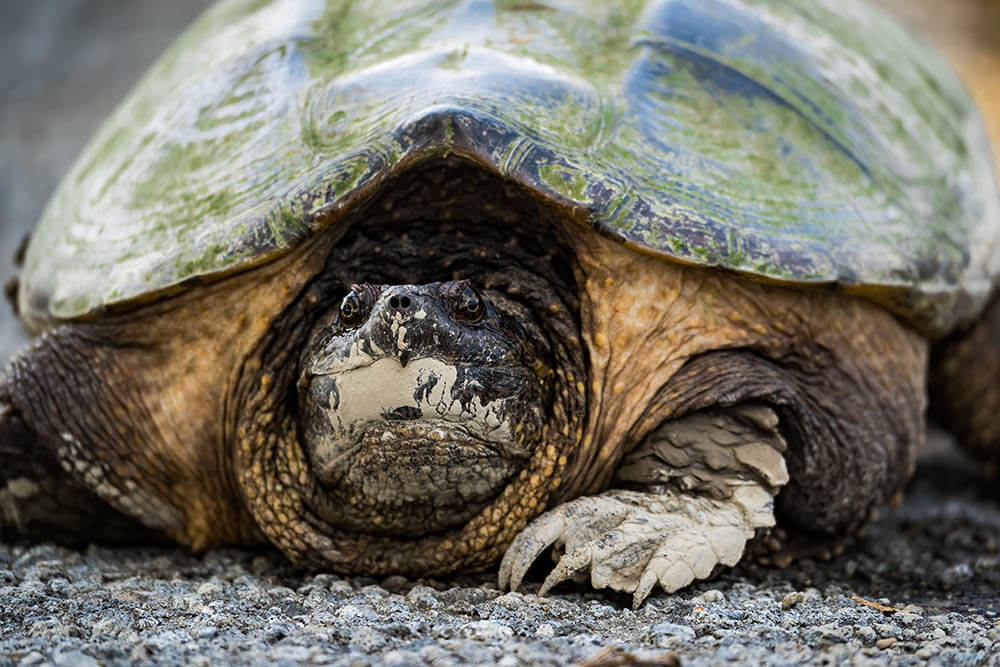
Feeding a Pet Snapping Turtle
Below are pointers on how to feed your pet snapper.
Don’t overfeed your snapper
Snapping turtles are prone to obesity. As such, don’t overfeed them. Give an adult snapper food only two to three times per week. A juvenile should be fed every two days, while a hatchling should eat twice daily.
In addition, make sure your pet eats the right amount of food per meal. To determine the appropriate portion size for your pet, you can use the following two methods:
The 15-minute method
Put some food in your pet’s enclosure, then leave it alone so it can enjoy its meal. Return 15 minutes later and remove any food it hasn’t eaten yet.
A snapping turtle will become full 15 minutes after it starts chowing down on goodies. However, if you don’t remove the leftovers, it’ll continue to feed, resulting in overeating. Therefore, it’s important to take away the leftovers once those 15 minutes are up.
This method could lead to food waste. However, you can always store the leftovers and reuse them for your pet’s next meal.
The head method
This is as simple as feeding your snapper an amount of food that’s equal to the size of its head.
One way to do this is to take a container (such as a bowl) that’s the same size as your pet’s head, then fill it with a combination of foods. Give this food to your pet to eat.
Feed your snapper in a separate container
Don’t feed your snapper in the enclosure where it relaxes in. This is because these turtles are messy eaters and tend to defecate not long after a meal. If it eliminates in its original enclosure, you’re going to have a tough time cleaning it.
Come mealtime, transfer your pet into a smaller container. After it has finished eating, wait for it to relieve itself, which it should accomplish within 30 minutes. Only once this is done should you return it to its original enclosure.
Don’t hand-feed your snapper
Common snapping turtles boast a bite force of up to 209 Newtons, while alligator snapping turtles have a bite force of around 158 Newtons. These powerful bites in combination with their sharp beaks allow both species to easily slice your fingers off.
To protect yourself from harm when it comes time to give your exotic critter its meal, suspend its food using tools such as tongs or forceps.
Fun and Quick Snapping Turtle Facts
It’s time to expand our knowledge of snapping turtles!
- Snapping turtles can be found in North America and Mexico.
- The bite forces of common snapping turtles and alligator snapping turtles (209 Newtons and 158 Newtons respectively) pale in comparison to the bite force we humans are capable of when biting down with our molars (up to 1300 Newtons).
- Unlike smaller turtles, snapping turtles can’t fully retreat into their shell. To keep themselves safe from danger, they instead developed a powerful bite that can deter attacks from predators.
- Common snapping turtles generally live from 30 to 50 years. Alligator snapping turtles can have a lifespan lasting 11 to 45 years.
- Common snappers have a smoother shell, while alligator snappers have a shell with three prominent ridges.
- Common snappers typically weigh about 16 kilograms and have a shell measuring 25 to 50 centimeters long. Alligator snappers can weigh more than 100 kilograms and boast a shell up to 80 centimeters.
- Baby snappers grow quickly, reaching around 3 inches (7.6 centimeters) during their first year. They then grow about 1 inch (2.5 centimeters) every year after this.
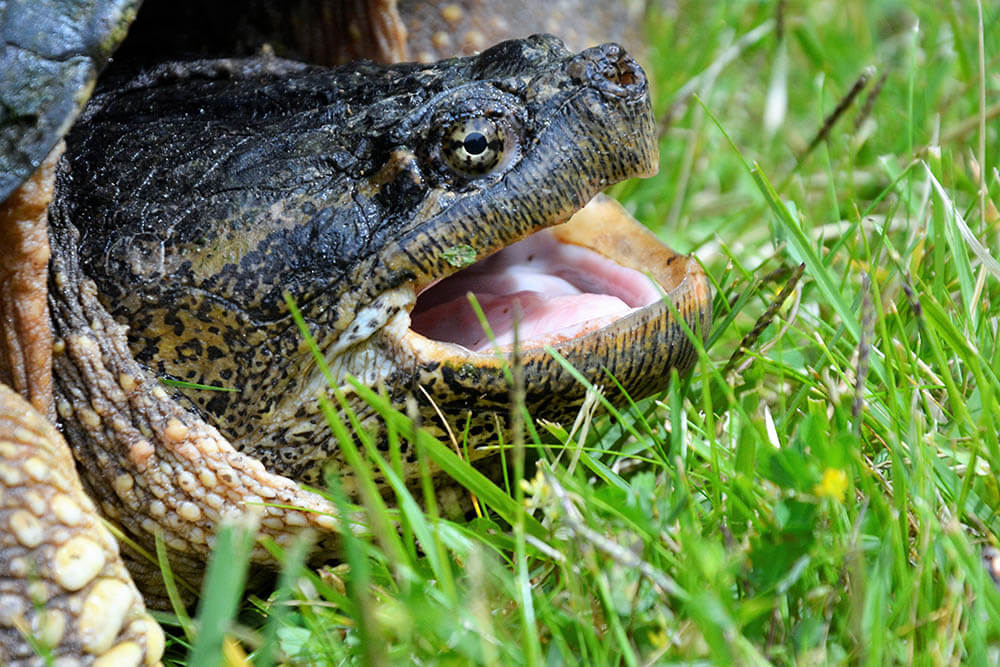
Conclusion
Snapping turtles eat a huge range of foods, including other animals, vegetables, and fruits. And if we’re talking about a snapper in captivity, we can add commercial foods and supplements to its list of edibles.
If you’re the owner of such an exotic pet, make sure you feed it the foods it will benefit from the most and avoid foods that can harm it. Also, never overfeed your snapper, feed it by hand, or feed it in the same space it relaxes in. This way, you can avoid problems such as health issues and having to clean up a filthy enclosure.
